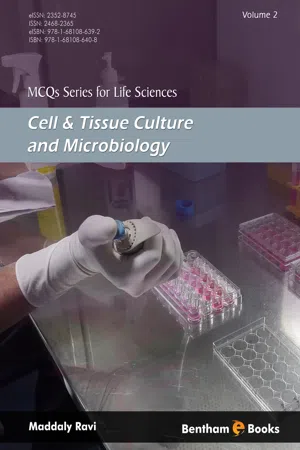
This is a test
- English
- ePUB (mobile friendly)
- Available on iOS & Android
eBook - ePub
MCQs Series for Life Sciences: Volume 2
Book details
Book preview
Table of contents
Citations
About This Book
Today's academic environment presents assessment challenges defined by an increased volume of available information coupled with increased competition among students and time constraints. Multiple choice questions MCQs provide examiners with an opportun
Frequently asked questions
At the moment all of our mobile-responsive ePub books are available to download via the app. Most of our PDFs are also available to download and we're working on making the final remaining ones downloadable now. Learn more here.
Both plans give you full access to the library and all of Perlego’s features. The only differences are the price and subscription period: With the annual plan you’ll save around 30% compared to 12 months on the monthly plan.
We are an online textbook subscription service, where you can get access to an entire online library for less than the price of a single book per month. With over 1 million books across 1000+ topics, we’ve got you covered! Learn more here.
Look out for the read-aloud symbol on your next book to see if you can listen to it. The read-aloud tool reads text aloud for you, highlighting the text as it is being read. You can pause it, speed it up and slow it down. Learn more here.
Yes, you can access MCQs Series for Life Sciences: Volume 2 by Maddaly Ravi in PDF and/or ePUB format, as well as other popular books in Education & Teaching Science & Technology. We have over one million books available in our catalogue for you to explore.
Information
Topic
EducationSubtopic
Teaching Science & TechnologyPart I: Cell and Tissue Culture
Types of Animal Cell Cultures and Major Discoveries
Maddaly Ravi
- Primary cell cultures are obtained from
- Tissues or organs of life forms
- From continuous cell lines
- From cancer cell lines
- From transformed cells
- Cells for primary cultures are obtained from their source tissue by
- Enzymatic or mechanical dissociation
- By chemical digestion
- By increased temperatures
- By transformation
- Adherent cells are also known as
- Suspension cells
- Aggregates
- Anchorage dependent cells
- Transformed cells
- Adherent cells typically form
- Single cell cultures
- Suspension cells
- Aggregates
- Monolayers
- Non-adherent cells typically form
- Single cell cultures
- Suspension cultures
- Aggregates
- Monolayers
- Secondary cell cultures are obtained from
- Stem cells
- Source tissues or organs
- Primary cultures
- 3D aggregates
- Subculturing of cells in cultures is also known as
- Typsinization
- Passaging
- Acclimatization
- Conditioning
- Cell lines can be
- Finite
- Continuous
- Finite or continuous
- Transforming cells
- Contact inhibition property is typical of
- Finite cell lines
- Continuous cell lines
- Suspension cell lines
- 3D aggregates
- Explant cultures are a type of
- Primary cells
- Secondary cells
- Transformed cells
- Continuous cell lines
- The type of cultures that typically dominated by fibroblasts are
- 3D cultures
- Co-cultures
- Explant cultures
- Transformed cell cultures
- Continuous cell lines are obtained by
- Fusion
- Transformation
- Passaging
- Selection
- 2-dimensional cell cultures include
- Adherent cultures
- Suspension cells
- Both adherent and suspension cultures
- Aggregates
- Adherent cell lines usually form
- Monolayers
- Stratified layers
- Necrotic cores
- Aggregates
- The cell types that retain highest biotransformation ability are
- Continuous cell lines
- Finite cell lines
- Primary cells
- Secondary cell lines
- The cell types that retain highest tissue-distinct functions are
- Continuous cell lines
- Finite cell lines
- Primary cells
- Secondary cell lines
- The cells of the circulatory system are cultured as
- Monolayers
- Adherent cells
- Suspension cells
- Aggregates
- The type of cultured cells with elongated bipolar morphology are typically
- Epithelial-like
- Fibroblastic
- Lymphoblast-like
- Spheroid-like
- The type of cultured cells with polygonal or other regular morphology are typically
- Epithelial-like
- Fibroblastic
- Lymphoblast-like
- Spheroid-like
- The type of cultured cells with spherical morphology are typically
- Epithelial-like
- Fibroblastic
- Lymphoblast-like
- Spheroid-like
- Cell aggregates are typically formed by
- Monolayer cell cultures
- Suspension cell cultures
- 3D cell cultures
- Primary cell cultures
- A distinct tissue-like morphology can be obtained by culturing cells as
- Monolayer cell cultures
- Suspension cell cultures
- 2D cell cultures
- 3D cell cultures
- The type of cell cultures that required a matrix or scaffold is
- 2D cultures
- 3D cult...
Table of contents
- Welcome
- Table of Contents
- Title
- BENTHAM SCIENCE PUBLISHERS LTD.
- PREFACE
- ANNEXURE
- Part I: Cell and Tissue Culture
- Types of Animal Cell Cultures and Major Discoveries
- Animal Cell Culture Media and Supplements
- Animal and Human Cell Lines
- Hybridoma Technology
- 3D Cell Cultures
- Stem Cells
- Part II: Microbiology
- History of Microbiology
- Microbial Taxonomy and Diversity
- Microbial Structure and Function
- Microbial Growth and Cultures
- Microbial Metabolism
- Microbial Genetics
- Microbial Control
- Microbial Diseases